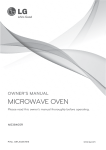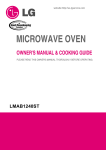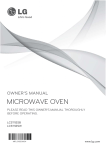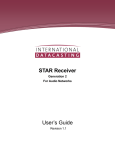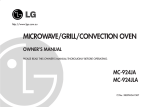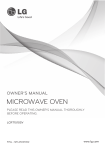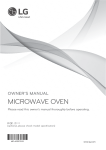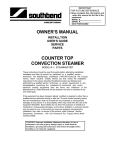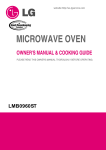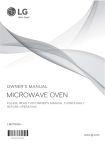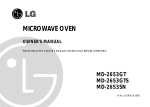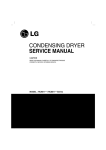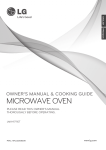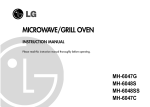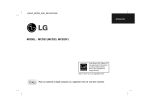Download OWNER`S MANUAL MICROWAVE OVEN
Transcript
OWNER’S MANUAL
MICROWAVE OVEN
Please read this owner’s manual thoroughly before operating.
.4 ***
(optional, please check model specification)
MFL40257831
www.lg.com
PRECAUTIONS
Precautions to avoid possible exposure to excessive microwave energy.
You cannot operate your oven with the door open due to the safety interlocks built into the door
mechanism. These safety interlocks automatically switch off any cooking activity when the door is opened;
which in the case of a microwave oven could result in harmful exposure to microwave energy.
It is important not to tamper with the safety interlocks.
Do not place any object between the oven front face and the door or allow food or cleaner residue to
accumulate on sealing surfaces.
Do not operate your oven if it is damaged. It is particularly important that the oven door closes properly and
that there is no damage to the: (1) door(bent), (2) hinges and latches (broken or loosened), (3) door seals
and sealing surfaces.
Your oven should not be adjusted or repaired by anyone except qualified service personnel.
Warning
Please ensure cooking times are correctly set as over cooking may result in the FOOD catching
fire and subsequent damage to your oven.
When heating liquids, e.g. soups, sauces and beverages in your microwave oven, overheating the liquid
beyond boiling point can occur without evidence of bubbling. This could result in a sudden boil over of the
hot liquid. To prevent this possibility the following steps should be taken:
1. Avoid using straight sided containers with narrow necks.
2. Do not overheat.
3. Stir the liquid before placing the container in the oven and again halfway through the heating time.
4. After heating, allow to stand in the oven for a short time and check the temperature of the liquid before
consumption to avoid burns (especially, contents of feeding bottles and baby food jars).
Warning
Always allow food to stand after being cooked by microwaves and check the temperature of
them before consumption. Especially contents of feeding bottles and baby food jars.
Never leave lids on bottles when heating as they will explode and may cause personal injury
and damage the oven.
How the Microwave Oven Works
Microwaves are a form of energy similar to radio and television waves and ordinary daylight. Normally,
microwaves spread outwards as they travel through the atmosphere and disappear without effect.
Microwave ovens, however, have a magnetron which is designed to make use of the energy in microwaves.
Electricity, supplied to the magnetron tube, is used to created microwave energy.
These microwaves enter the cooking area through openings inside the oven. A turntable or tray is located
at the bottom of the oven. Microwaves cannot pass through metal walls of the oven, but they can penetrate
such materials as glass, porcelain and paper, the materials out of which microwave-safe cooking dishes are
constructed.
Microwaves do not heat cookware, though cooking vessels will eventually get hot from the heat generated
by the food.
With Safety in mind
Your microwave oven has built in safety features for peace of mind. When the door is opened, the
oven automatically stops producing microwaves. Microwave energy is converted completely to
heat when it enters food, leaving no “left over” energy to harm you when you eat your food.
2
CONTENTS
PRECAUTIONS
2
CONTENTS
3
UNPACKING & INSTALLING
4-5
FEATURE DIAGRAM
6
CONTROL PANEL
6
OPERATING INSTRUCTIONS
7
SETTING CLOCK
7
ENERGY SAVING
7
CHILD LOCK
7
QUICK TOUCH COOKING
8
QUICK TOUCH COOKING TABLE
8
MICROWAVE COOKING
9
2 OR 3 STAGE TIMED COOKING
9
MICROWAVE POWER LEVELS
9
QUICK START
9
MELT
10
MELT TABLE
10
SOFTEN
10
SOFTEN TABLE
10
AUTO DEFROST
11
EXPRESS DEFROST
12
BREAD DEFROST
12
AUTO DEFROST TABLE
12
HEATING OR REHEATING GUIDE
13
FRESH VEGETABLE GUIDE
14
MICROWAVE-SAFE UTENSILS
15
FOOD CHARACTERISTICS & MICROWAVE COOKING
16 - 17
SAFETY PRECAUTIONS
18 - 19
QUESTION & ANSWERS
19
PLUG WIRING INFORMATION/TECHNICAL SPECIFICATIONS
20
3
UNPACKING & INSTALLING
By following the basic steps on these two pages you will be able to quickly check that your oven
is operating correctly. Please pay particular attention to the guidance on where to install your
oven. When unpacking your oven make sure you remove all accessories and packing.
Check to make sure that your oven has not been damaged during delivery.
Unpack your oven and place it on a flat level surface.
GLASS TRAY
ROTATING RING
Place your oven on a flat, level surface but make sure there is at least 20 cm of space on the
top and 10 cm on the rear and sides so there is air flow for ventilation. Exhaust outlets are
located in the back and side of your oven. Blocking the outlets can damage your oven. The microwave
oven must not be placed in a cabinet.
THIS OVEN SHOULD NOT BE USED FOR COMMERCIAL
CATERING PURPOSES, IT IS INTENDED FOR INDOOR
DOMESTIC USE ONLY AND FOR THE PURPOSES OF
HEATING OR COOKING FOODS.
4
UNPACKING & INSTALLING
Plug your oven into a standard household socket. Make sure your oven is the only appliance
connected to the socket. If your oven does not operate properly, unplug it from the
electrical socket and then plug it back in.
Open your oven door by pressing the DOOR OPEN button.
Place the ROTATING RING inside the oven and
place the GLASS TRAY on top.
Fill a microwave safe container with 300 ml (1/2 pint) of water. Place on the GLASS TRAY
and close the oven door. If you have any doubts about what type of container to use please
refer to page 15.
automatically.
Enter the time by touching [3] and [0].
And touch START/Q-START.
30
SECONDS
The DISPLAY will count down from 30 seconds. When it reaches 0 it will sound BEEPS.
Open the oven door and test the temperature of the water. If your oven is operating the water
should be HOT. Be careful when removing the container it may be hot.
YOUR OVEN IS NOW INSTALLED
5
FEATURE DIAGRAM
Window Door Screen
Remove your Microwave Oven and all
material from the shipping carton.
Your oven will be packed with the
following materials:
Oven Front Plate
Door Seal
Display Window
Glass Turntable .........................1 each
Control Panel
Owner's Manual .........................1 e ach
Rotating Ring.............................1 each
Door Open Button
Safety Door Lock System
This microwave oven is designed
for household use only. It is not
recommended for commercial
purposes.
Glass Turntable
Rotating Ring
CONTROL PANEL
NOTE: A beep sounds when a key pad on the control panel
is touched to indicate that the setting has been entered.
6
OPERATING INSTRUCTIONS
CHILD LOCK
SETTING CLOCK
This is a unique safety feature that prevents
unwanted oven operations. Once the CHILD
LOCK is set, no cooking can take place.
When your oven is plugged in for the first time or
when power resumes after a power interruption,
the numbers in the display reset to "0".
Example:To set 11:11.
To set the child lock
Touch and hold STOP/CLEAR
or 0, until L appears in the
display and two beeps are
heard. If the time of day was
already set, the time of day will
disappear on the display window.
1. Touch STOP/CLEAR.
2. Touch CLOCK once.
3. Enter the time by using
the number key pads.
("11:11")
If the CHILD LOCK was already set and you
touch another cooking pad, the word L
shows in the display. You can cancel the
CHILD LOCK according to below procedure.
To cancel the child lock
4. Touch START/Q-START
Touch and hold the STOP/CLEAR
or 0, key pad until L disappears
in the display.
ENERGY SAVING
ECO ON feature saves energy by turning off
the display.This feature only operates when the
STOP/ CLEAR (ECO ON) button is touched and
then cancels when the door is opened or any button
is touched.
After the CHILD LOCK is turned off, the time of
day will return to the display window. The oven
will operate normally.
To set the ECO ON
1. Touch STOP/CLEAR (ECO ON)
The display will go out and
ECO ON will be active.
Touch the STOP/CLEAR (ECO ON) or any
other button to cancel this feature when it is on.
7
OPERATING INSTRUCTIONS
QUICK TOUCH COOKING
Example: To cook 1 potato
Use this function to cook food without entering a
cook time or power. Refer to the Quick Touch
Cooking Table below for more information.
1. Touch STOP/CLEAR.
Example: To cook a 100 g. bag of microwave
popcorn.
Example
: One touch Auto Menu (popcorn 100g)
2. Touch POTATO once.
then the oven will start
automatically.
1. Touch STOP/CLEAR.
2. Touch POPCORN once.
then the oven will start
automatically.
QUICK TOUCH COOKING TABLE
Category
Touch
S erving size
Directions
1 time
2 times
100 g
85 g
• Follow package instructions.
• Do not try to pop unpopped kernels.
• Heat only 1 package at a time.
Potato
1
2
3
4
1
2
3
4
• 227-284 g per potato.
• Pierce potato several times with fork.
• Place in center of the turntable tray on paper towel.
• After cooking, let stand for 5 minutes.
Frozen
Entree
1 time
284 g
• Remove from outer display package.
• If not in microwave-safe container, place on plate and cover with
plastic wrap and vent.
1
2
3
4
1
2
3
4
• Prepare as desired, wash, and leave residual water on
the vegetables.
• Place the appropriately-sized microwave container.
• Cover with plastic wrap and vent.
Popcorn
Vegetable
time
times
times
times
time
times
times
times
ea
ea
ea
ea
( 227 g )
( 454 g )
( 681 g )
( 908 g )
cup
cups
cups
cups
Dinner Plate
1 time
2 times
300 g
454 g
• Arrange food on the microwave plate.
• Place meaty portions and bulky vegetables to the outside
of the plate.
• Cover with plastic wrap and vent.
• After cooking , let stand for 2 minutes.
Hot Dog
1 time
2 times
3 times
4 times
5 times
6 times
1
2
3
4
5
6
• Pierce the skin and place hot dogs in microwave-safe bowl.
• Cover with water.
• Heat uncovered.
• After heating, stir well.
• Drain and serve.
ea
ea
ea
ea
ea
ea
8
OPERATING INSTRUCTIONS
MICROWAVE COOKING
MICROWAVE POWER LEVELS
Your microwave oven is equipped with eleven
power levels to give you maximum flexibility and
control over cooking. The adjacent table will give you
some idea of which foods are prepared at each of
the various power levels.
* The below chart shows the power level settings
for your oven.
This function allows you to cook food for a
desired time. There are 11 power levels available.
The example below shows how to set 80% power
level for the desired time.
Example:To cook food on 80% Power (Power8)
for 5 minutes 30 seconds
Microwave Power Level Table
Power
Level
1. Touch STOP/CLEAR.
•
•
•
•
•
•
•
•
•
•
•
•
•
•
•
•
•
Boiling water.
Making candy.
Cooking poultry pieces, fish, & vegetables.
Cooking tender cuts of meat.
Whole poultry.
Reheating rice, pasta, & vegetables.
Reheating prepared foods quickly.
Reheating sandwiches.
Cooking egg, milk, & cheese dishes.
Cooking cakes, breads.
Melting chocolate.
Cooking veal.
Cooking whole fish.
Cooking puddings & custard.
Cooking ham, whole poultry, & lamb.
Cooking rib roast, sirloin tip.
Thawing meat, poultry, & seafood.
1
•
•
•
•
•
•
Cooking less tender cuts of meat.
Cooking pork chops, roast.
Taking chill out of fruit.
Softening butter.
Keeping casseroles & main dishes warm.
Softening butter & cream cheese.
0
• Standing time.
10
(High)
2. Touch TIME.
9
3. Enter 5 minutes
30 seconds by touching
[5], [3],and [0].
8
7
4. Touch POWER.
P-HI appears in the
display. This is to tell you
that the oven is set on HI
unless a different power
setting is chosen.
6
5
5. Touch 8.
To select power level 80%.
Display shows P-80.
4
6. Touch START/Q-START.
2
3
When cooking is complete, four short tones will
sound. The word End shows in the display window.
Then the oven shuts itself off.
Use
QUICK START
NOTE:
If you do not select the power level, the oven will
operate at power HIGH. To set HI-POWER
cooking, skip steps 4 & 5 above.
The QUICK START feature allows you to set 30 seconds
intervals of HIGH power cooking with a touch of the
START/Q-START.
Example: Set 2 minutes of cooking on high power.
2 or 3 STAGE TIMED COOKING
For Two Stage cooking, repeat timed cooking
steps 2 to 5 from the above example before pressing
the START/Q-START button. The 2nd stage will
continue on from the 1st stage and apply the set
time and set power level automatically.
Auto Weight Defrost can be programmed as the first
stage to defrost first and then a second stage cook.
1.
1. Touch STOP/CLEAR.
2.
2. Touch START/Q-START
Four times on high power
The oven will start before you have
finished the fourth touch.
During QUICK START cooking,you can extend the
cooking time up to 10 minutes by repeatedly touching
the START/Q-START key if longer cooking times are
required.
9
OPERATING INSTRUCTIONS
MELT
MEL
T
SOFTEN
The oven uses low power to melt foods (butter,
chocolate, marshmallows and cheese). See the
following table.
The oven uses low power to soften foods (butter, ice
cream, cream cheese, and frozen juice)
See the following table.
Example
227g chocolate.
Chocolate.
E
xample: :TTo
o MMelt
elt 227g
Example : To Soften 227g Cream Cheese.
1. Touch STOP/CLEAR.
1. Touch STOP/CLEAR.
2. Touch MELT two times.
2. Touch SOFTEN three times.
‘2’ appears in the display.
‘3’ appears in the display.
3. Touch number 2.
‘227’ appears in the display.
3. Touch number 2.
‘227’ appears in the display.
4. Touch START/Q-START.
4. Touch START/Q-START.
When the cook time is over,
you will hear four beeps and
END will be displayed.
When the cook time is over,
you will hear four beeps and
END will be displayed.
MELT TABLE
Code
1
2
Category
SOFTEN TABLE
Direction
Unwrap and place in
Butter/ microwavable container
Marga- No need to cover butter .
Stir at the end of cooking.
rine to
be moved down and over.
Amount
Code
Choose the 4 or 8 oz.(actual
weight) selection to melt
squares of baking chocolate
or chocolate morsels.
Unwrap squares and place
113 or
ChocoChoco - them in a microwavable
227 g
late
container. Stir at the end of
the cycle to complete melting.
4
Use processed cheese
food only
only.. Cut into cubes.
.
Place in a single layer in
Cheese
microwavable container
Stir at the end of cooking
to complete melting.
227 or
454 g
Large or miniature
marshmallows may be
Marsh- used. Place in
.
mallows microwavable container
Stir at the end of cycle to
complete melting.
142 or
284 g
10
Direction
Amount
1
Butter
Unwrap and place in
microwavable container.
No need to cover butter.
Butter will be at room
temperature and ready
for use in recipe.
2
Ice
Cream
Place container in oven.
Ice cream will be soft
enough to make
scooping easier.
Pint,
Quart,
Half
gallon
3
Unwrap and place in
microwavable container.
Cream Cream cheese will be at
Cheese room temperature and
ready for use in recipe.
85 or
227 g
4
Remove top.
170, 340
Frozen Place in oven.
or 454 g
Juice Frozen juice will be soft
enough to easily mix with
water.
1, 2 or
3 sticks
NOTE:
Add time if necessary to
complete melting.
3
Category
1, 2 or
3 sticks
OPERATING INSTRUCTIONS
AUTO DEFROST
START/Q-START
Three defrost sequences are preset in the oven.
The auto defrost feature provides you with the best
defrosting method for frozen foods. The cooking guide
will show you which defrost sequence is recommended
for the food you are defrosting.
For added convenience, the Auto Defrost
includes a built-in beep mechanism that reminds
you to check, turn over, separate, or rearrange to get
the best defrost results. Three different defrosting levels
are provided.
START/Q-START t
*For best results, remove fish, shellfish, meat,
and poultry from its original wrapping paper or
plastic package. Otherwise, the wrap
will hold steam and juice close to the foods,
which can cause the outer surface of the foods
to cook.
1 MEAT
2 POULTRY
3 FISH
*For best results, shape your ground meat into
the form of a doughnut before freezing. When
defrosting, separate any thawed meat when the
beep sounds and continue defrosting.
*Available weight is 0.1~4.0 kg.
*Place foods in a shallow container or on a
microwave roasting rack to catch drippings.
1. Touch STOP/CLEAR.
*Food should still be somewhat icy in the center
when removed from the oven.
2. Touch AUTO DEFROST one time.
‘dEF1’ appears in the display.
3.
4
START/Q-START
11
OPERATING INSTRUCTIONS
EXPRESS DEFROST
AUTO DEFROST TABLE
Category
This feature should be used only when you defrost
0.5 kg of frozen ground beef.
Example: To defrost 0.5 kg Ground beef.
1. Touch STOP/CLEAR.
MEAT
2. Touch EXPRESS DEFROST .
POULTRY
BREAD DEFROST
The bread defrost feature provides you with the best
defrosting method for frozen bread.
*Available weight is 0.1~0.5 kg.
FISH
Example: To defrost 0.1 kg of bread.
1. Touch STOP/CLEAR.
2. Touch BREAD DEFROST.
3.
4
START/Q-START
12
Food to be Defrosted
Beef
Ground beef, Round steak,
Cubes for stew, Tenderloin steak,
Pot roast, Rib roast, Rump roast,
Chuck roast, Hamburger patty
Lamb
Chops (25.4 mm thick), Rolled roast
Pork
Chops (12.7 mm thick), Hot dogs,
Spareribs, Country-style ribs.
Rolled roast, Sausage
Veal
Cutlets (0.5 kg, 12.7 mm thick)
Poultry
Whole (under 4.0 kg.), Cut-up, Breast
(boneless)
Cornish Hens
Whole
Turkey
Breast
Steaks/Chops
Round beef steak, Tenderloin steak
Lamb chops (25.4 mm thick)
Pork chops (12.7 mm thick)
Veal cutlets (0.5 kg, 1/2 inch thick)
Fish
Fillets, Whole Steaks
Shellfish
Crab meat, Lobster tails, Shrimp,
Scallops
OPERATING INSTRUCTIONS
HEATING OR REHEATING GUIDE
To heat or reheat successfully in the microwave, it is important to follow several guidelines. Measure the
amount of food in order to determine the time needed to reheat. Arrange the food in a circular pattern for
best results. Room temperature food will heat faster than refrigerated food. Canned foods should be taken
out of the can and placed in a microwavable container. The food will be heated more evenly if covered with
a microwavable lid or plastic wrap and vented. Remove cover carefully to prevent steam burns. Use the
following chart as a guide for reheating cooked food. Never cook or reheat with lids fitted to
containers or bottles.
Items
Cook time
Special Instructions
(at HIGH)
Sliced meat
3 slices (0.5 cm thick)
Chicken pieces
1 breast
1 leg and thigh
1-2 minutes
2-3 minutes
3-31/2 minutes
Place sliced meat on microwavable plate.
Cover with plastic wrap and vent.
*Note: Gravy or sauce helps to keep meat juicy.
Place chicken pieces on microwavable plate. Cover with plastic
wrap and vent.
Fish fillet
(230 g)
1-2 minutes
Place fish on microwavable plate. Cover with plastic wrap and
vent.
Lasagna
1 serving (300 g)
4-6 minutes
Place lasagna on microwavable plate. Cover with plastic wrap
and vent.
11/2 -3 minutes
41/2 -7 minutes
COOK covered in microwavable casserole dish. Stir once halfway
through cooking.
1-21/2 minutes
31/2-6 minutes
COOK covered in microwavable casserole dish. Stir once halfway
through cooking.
1 -21/2 minutes
Reheat filling and bread separately.
Cook filling covered in microwavable casserole dish. Stir once.
Heat bun as directed in chart below.
11/2 -31/2 minutes
6-9 minutes
COOK covered in microwavable casserole dish. Stir once halfway
through cooking.
11/2-3 minutes
COOK covered in microwavable casserole dish. Stir once halfway
through cooking.
Casserole
1 cup
4 cups
Casserole –
cream or cheese
1 cup
4 cups
Sloppy Joe or
Barbecued beef
1 sandwich
(1/2 cup meat filling)
without bun
Mashed potatoes
1 cup
4 cups
Baked beans
1 cup
Ravioli or pasta in sauce
1 cup
4 cups
Rice
1 cup
4 cups
Sandwich roll or bun
1 roll
21/2-4 minutes
71/2-11 minutes
1 -11/2 minutes
31/2-5 minutes
15-30 seconds
Vegetables
1 cup
4 cups
11/2-21/2 minutes
4-6 minutes
Soup
1 serving (230 g)
11/2-2 minutes
COOK covered in microwavable casserole dish. Stir once halfway
through cooking.
COOK covered in microwavable casserole dish. Stir once halfway
through cooking.
Wrap in paper towel and place on glass mircrowavable rack
COOK covered in microwavable casserole dish. Stir once halfway
through cooking.
COOK covered in microwavable casserole dish. Stir once halfway
through cooking.
13
OPERATING INSTRUCTIONS
FRESH VEGETABLE GUIDE
Amount
Cook time
at HIGH
Artichokes
(230 g each)
2 medium
4 medium
41/2 ~7
10~12
Trim. Add 2 tsp water and 2 tsp juice. Cover.
2-3 minutes
Asparagus,
Fresh, Spears
450 g
21/2 ~6
Add 1 cup water. Cover.
2-3 minutes
Beans, Green &
Wax
450 g
7~11
Add 1/2 cup water in 11/2 qt. casserole dish. Stir
halfway through cooking.
2-3 minutes
Beets, Fresh
450 g
11~16
Add 1/2 cup water in 11/2 qt. covered casserole dish.
Rearrange halfway through cooking.
2-3 minutes
Broccoli, Fresh,
Spears
450 g
5~8
Place broccoli in baking dish. Add 1/2 cup water.
2-3 minutes
Cabbage, Fresh,
Chopped
450 g
4~7
Add 1/2 cup water in 11/2 qt. covered casserole dish.
Stir halfway through cooking.
2-3 minutes
Carrots, Fresh,
Sliced
2 cups
2~3
Add 1/4 cup water in 1 qt. covered casserole dish.
Stir halfway through cooking.
2-3 minutes
Cauliflower,
Fresh, Whole
450 g
5~7
Trim. Add 1/4 cup water in 1 qt. covered casserole dish.
Stir halfway through cooking.
2-3 minutes
Flowerettes, Fresh
2 cups
4 cups
Slice. Add 1/2 cup water in 11/2 qt. covered casserole dish.
Stir halfway through cooking.
2-3 minutes
Celery, Fresh,
Sliced
21/2~41/2
6~8
Corn, Fresh
2 cobs
Husk. Add 2 tbsp water in 11/2 qt. baking dish.
Cover.
2-3 minutes
Mushrooms,
Fresh, Sliced
230 g
Place mushrooms in 11/2 qt. covered casserole dish.
Stir halfway through cooking.
2-3 minutes
Parsnips, Fresh,
450 g
4~7
Add 1/2 cup water in 11/2 qt. covered casserole dish.
2-3 minutes
4 cups
6~9
Add 1/2 cup water in 11/2 qt. covered casserole dish.
Stir halfway through cooking.
2-3 minutes
Sweet Potatoes
Whole Baking
(170~230 g each)
2 medium
4 medium
4~9
6~12
Pierce potatoes several times with fork.
Place on 2 paper towels.
Turn over halfway through cooking.
2-3 minutes
2-3 minutes
White Potatoes,
Whole Baking
(170~230 g each)
2 potatoes
4 potatoes
5~8
10~14
Pierce potatoes several times with fork.
Place on 2 paper towels.
Turn over halfway through cooking.
2-3 minutes
2-3 minutes
450 g
4~7
Add 1/2 cup water in 2 qt. covered casserole dish.
2-3 minutes
Squash, Acorn or
Butternut, Fresh
1 medium
6~8
Cut squash in half. Remove seeds.
Place in 8 x 8-inch baking dish. Cover.
2-3 minutes
Zucchini, Fresh,
Sliced
450 g
41/2~71/2
Add 1/2 cup water in 11/2 qt. covered casserole dish.
Stir halfway through cooking.
2-3 minutes
Zucchini, Fresh,
Whole
450 g
6~9
Pierce. Place on 2 paper towels.
Turn zucchini over and rearrange halfway through
cooking.
2-3 minutes
Vegetable
4~8
21/2~31/2
Sliced
Peas, Green,
Fresh
Spinach, Fresh,
Leaf
Instructions
Standing
Time
Stir halfway through cooking.
14
MICROWAVE-SAFE UTENSILS
Never use metal or metal trimmed utensils in
your microwave oven
Microwaves cannot penetrate metal. They will
bounce off any metal object in the oven and
cause arcing, an alarming phenomenon that
resembles lightning.
Most heat resistant non metallic cooking utensils
are safe for use in your microwave oven.
However, some may contain materials that
render them unsuitable as microwave cookware.
If you have any doubts about a particular utensil,
there’s a simple way to find out if it can be used
in your microwave oven.
Place the utensil in question next to a glass bowl
filled with water in the microwave oven.
Microwave at power HIGH for 1 minute. If the
water heats up but the utensil remains cool to the
touch, the utensil is microwave-safe. However, if
the water does not change temperature but the
utensil becomes warm, microwaves are being
absorbed by the utensil and it is not safe for use
in the microwave oven. You probably have many
items on hand in your kitchen right now that can
be used as cooking equipment in your microwave
oven. Just read through the following checklist.
Dinner plates
Many kinds of dinner-ware are microwave-safe. If
in doubt consult the manufacturer’s literature or
perform the microwave test.
Glassware
Glassware that is heat-resistant is microwavesafe. This would include all brands of oven
tempered glass cookware. However, do not use
delicate glassware, such as tumblers or wine
glasses, as these might shatter as the food
warms.
Plastic storage containers
These can be used to hold foods that are to be
quickly reheated. However, they should not be
used to hold foods that will need considerable
time in the oven as hot foods will eventually warp
or melt plastic containers and cause them to
pressurize and possibly explode.
Paper
Paper plates and containers are convenient and
safe to use in your microwave oven, provided that
the cooking time is short and foods to be cooked
are low in fat and moisture. Paper towels are also
very useful for wrapping foods and for lining
baking trays in which greasy foods such as bacon
are cooked. In general, avoid colored paper
products as the colour may run. Some recycled
paper products may contain impurities which
could cause arcing or fires when used in the
microwave oven.
Plastic cooking bags
Provided they are made specially for cooking,
cooking bags are microwave safe. However, be
sure to make a slit in the bag so that steam can
escape. Never use ordinary plastic bags for
cooking in your microwave oven, as they will melt
and rupture.
Plastic microwave cookware
A variety of shapes and sizes of microwave
cookware are available. For the most part, you
can probably use items you already have on
hand rather than investing in new kitchen
equipment.
Pottery, stoneware and ceramic
Containers made of these materials are usually
fine for use in your microwave oven, but they
should be tested to be sure.
CAUTION
Some items with high lead or iron content are
not suitable for cooking utensils.
Do not use any China, pottery, or stoneware
utensils or items that are finished with reflective
paint. Using these can cause arcing and damage
the utensil.
15
FOOD CHARACTERISTICS & MICROWAVE COOKING
Keeping an eye on things
The recipes in this book have been formulated
with great care, but your success in preparing
them depends on how much attention you pay to
the food as it cooks. Always watch your food
while it cooks. Your microwave oven is equipped
with a light that turns on automatically when the
oven is in operation so that you can see inside
and check the progress of your food. Directions
given in recipes to elevate, stir, and the like
should be thought of as the minimum steps
recommended. If the food seems to be cooking
unevenly, simply make the necessary
adjustments you think appropriate to correct the
problem.
Factors affecting microwave cooking times
Many factors affect cooking times. The
temperature of ingredients used in a recipe
makes a big difference in cooking times. For
example, a cake made with ice-cold butter, milk,
and eggs will take considerably longer to bake
than one made with ingredients that are at room
temperature. All of the recipes in this book give a
range of cooking times. In general, you will find
that the food remains under-cooked at the lower
end of the time range, and you may sometimes
want to cook your food beyond the maximum time
given, according to personal preference. The
governing philosophy of this book is that it is best
for a recipe to be conservative in giving cooking
times. While overcooked food is ruined for good.
Some of the recipes, particularly those for bread,
cake, and custards, recommend that food be
removed from the oven when they are slightly
undercooked. This is not a mistake. When
allowed to stand, usually covered, these foods
will continue to cook outside of the oven as the
heat trapped within the outer portions of the food
gradually travels inward. If the food is left in the
oven until it is cooked all the way through, the
outer portions will become overcooked or even
burnt. You will become increasingly skilful in
estimating both cooking and standing times for
various foods.
Density of food
Light, porous food such as cakes and bread cook
more quickly than heavy, dense foods such as
roasts and casseroles. You must take care when
microwaving porous food that the outer edges do
not become dry and over cooked. Over cooked
foods can be a fire hazard.
Height of food
The upper portion of tall food, particularly roasts,
will cook more quickly than the lower portion.
Therefore, it is wise to turn tall food during
cooking, sometimes several times.
Moisture content of food
Since the heat generated from microwaves tends
to evaporate moisture, relatively dry food such as
roasts and some vegetables should either be
sprinkled with water prior to cooking or covered to
retain moisture.
Bone and fat content of food
Bones conduct heat and fat cooks more quickly
than meat. Care must be taken when cooking
bony or fatty cuts of meat that they do not cook
unevenly and do not become overcooked.
Quantity of food
The number of microwaves in your oven remains
constant regardless of how much food is being
cooked. Therefore, the more food you place in
the oven, the longer the cooking time. Remember
to decrease cooking times by at least one third
when halving a recipe.
Shape of food
Microwaves penetrate only about 2.5 cm into
food, the interior portion of thick foods are cooked
as the heat generated on the outside travels
inward. Only the outer edge of food is cooked by
microwave energy; the rest is cooked by
conduction. The worst possible shape for a food
that is to be microwaved is a thick square. The
corners will burn long before the centre is even
warm . Round thin foods and ring shaped foods
cook successfully in the microwave.
Covering
A cover traps heat and steam which causes food
to cook more quickly. Use a lid or microwave
cling film with a corner folded back to prevent
splitting.
Browning
Meats and poultry that are cooked fifteen minutes
or longer will brown lightly in their own fat. Food
that is cooked for a shorter period of time may be
brushed with a browning sauce such as
Worcestershire sauce, soy sauce or barbecue
sauce to achieve an appetizing colour. Since
relatively small amounts of browning sauce is
added to food, the original flavour of the recipe is
not altered.
Covering with greaseproof paper
Greaseproofing effectively prevents spattering
and helps food retain some heat. But because it
makes a looser cover than a lid or clingfilm, it
allows the food to dry out slightly.
Arranging and spacing
Individual foods such as baked potatoes, small
cakes and hors d’oeuvres will heat more evenly if
placed in the oven an equal distance apart,
preferably in a circular pattern. Never stack foods
on top of one another.
16
FOOD CHARACTERISTICS & MICROWAVE COOKING
Standing time
Stirring
Stirring is one of the most important of all
microwaving techniques. In conventional cooking,
food is stirred for the purpose of blending.
Microwaved food, however, is stirred in order to
spread and redistribute heat. Always stir from the
outside towards the centre as the outside of the
food heats first.
Foods are often allowed to stand for 3 to 10
minutes after being removed from the microwave
oven. Usually the foods are covered during
standing time to retain heat unless they are
supposed to be dry in texture (some cakes and
biscuits, for example). Standing allows foods to
finish cooking and also helps flavour blend and
develop.
Turning over
Large, tall foods such as roasts and whole
chickens should be turned so that the top and
bottom will cook evenly. It is also a good idea to
turn cut up chicken and chops.
To Clean Your Oven
1 Keep the inside of the oven clean
Food spatters or spilled liquids stick to oven walls
and between the oven and door surface. It is best to
wipe up spillovers with a damp cloth immediately.
Not doing so could cause the paint finish to become
damaged. Crumbs and spillovers will absorb microwave
energy and lengthen cooking times. Use a damp
cloth to wipe out crumbs that fall between the
door and the frame. It is important to keep this
area clean to assure a tight seal. Remove greasy
spatters with a soapy cloth then rinse and dry. Do
not use harsh detergent or abrasive cleaners.
The glass tray can be washed by hand or in the
dishwasher.
Placing thicker portions facing outwards
Since microwaves are attracted to the outside
portion of food, it makes sense to place thicker
portions of meat, poultry and fish to the outer
edge of the baking dish. This way, thicker
portions will receive the most microwave energy
and the food will cook evenly.
Shielding
Strips of aluminium foil (which block microwaves)
can be placed over the corners or edges of
square and rectangular food to prevent those
portions from overcooking. Never use too much
foil and make sure the foil is secured to the dish
and does not come into contact with the oven
cavity as it may cause ‘arcing’ in the oven.
2 Keep the outside of the oven clean
Clean the outside of your oven with soap and
water then with clean water and dry with a soft
cloth or paper towel. To prevent damage to the
operating parts inside the oven, the water should
not be allowed to seep into the ventilation
openings. To clean control panel, open the door
to prevent oven from accidentally starting, and
then wipe the control panel with a damp cloth,
followed immediately by a dry cloth. Press STOP
after cleaning whilst the door is still open.
Elevating
Thick or dense foods can be elevated so that
microwaves can be absorbed by the underside
and centre of the foods.
Piercing
Foods enclosed in a shell, skin or membrane are
likely to burst in the oven unless they are pierced
prior to cooking. Such foods include yolks and
whites of eggs, clams and oysters and whole
vegetables and fruits.
3 If steam accumulates inside or around the
outside of the oven door, wipe the panels with a
soft cloth. Condensation may also form inside the door.
To prevent or reduce this occurrence, reduce the
cooking power, or reduce the cooking time.
This may occur when the microwave
oven is operated under high humidity conditions
and in no way indicates a malfunction of the unit.
Testing if cooked
Food cooks so quickly in a microwave oven, it is
necessary to test it frequently. Some foods are
left in the microwave until completely cooked, but
most foods, including meats and poultry, are
removed from the oven while still slightly
undercooked and allowed to finish cooking during
standing time. The internal temperature of foods
will rise between 3°C and 8°C during standing
time.
4 The door and door seals should be kept clean.
Use only warm, soapy water, rinse then dry
thoroughly.
DO NOT USE ABRASIVE MATERIALS, SUCH
AS CLEANING POWDERS OR STEEL AND
PLASTIC PADS.
Metal parts will be easier to maintain if wiped
frequently with a damp cloth.
17
SAFETY PRECAUTIONS
WARNING
Please ensure cooking times are correctly set as over cooking may result in FIRE and
subsequent DAMAGE to the OVEN.
1 Do not attempt to tamper with, or make any
adjustments or repairs to the door, control panel,
safety interlock switches or any other part of the
oven. Repairs should only be undertaken by a
qualified service technician.
13 Do not cook eggs in their shell. Pressure will
build up inside the egg which will burst.
14 Do not attempt deep fat frying in your oven.
2 Do not operate the oven when empty. It is best to
leave a glass of water in the oven when not in
use. The water will safety absorb all microwave
energy, if the oven is accidentally started.
3 Do not use the oven for the purpose of
dehumidification. It can be the cause of serious
damage to the unit and could cause personal injury.
(eg: Operating the microwave oven with wet
newspapers, clothes, toys, pets or portable electric
devices, etc, inside.)
4 Do not cook food wrapped in paper towels,
unless your cook book contains instructions, for
the food you are cooking.
5 Do not use newspaper in place of paper towels
for cooking.
15 Remove the plastic wrapping from food before
cooking or defrosting. Note though that in some
cases food should be covered with plastic film,
for heating or cooking.
16 If the oven door is damaged, the oven must not
be operated until it has been repaired by a
qualified service technician.
17 If smoke is observed, keep the oven door
closed and switch off or disconnect the oven
from the power supply.
18 When food is heated or cooked in disposable
containers of plastic, paper or other combustible
materials look at the oven frequently to check if
the food container is deteriorating.
19 The appliance is not intended for use by young
children or infirm persons without supervision;
Young Children should be supervised to ensure
that they do not play with the appliance.
20 Liquids or other foods must not be heated in
sealed containers or semi sealed bottles of
any kind, since they are liable to explode.
Always remove the lids before operating
the oven.
21 If the appliance is supplied from a cord extension
set or an electrical portable outlet device,the cord
extension set on electrical portable outlet device
must be positioned so that it is not subject to
splashing or moisture ingress.
6 Do not use wooden containers. They may heatup and char. Do not use ceramic containers
which have metallic (e.g. gold or silver) inlays.
Always remove metal twist ties. Metal objects in
the oven may arc, which can cause serious
damage.
7 Do not operate the oven with a kitchen towel, a
napkin or any other obstruction between the door
and the front edges of the oven, which may
cause microwave energy leakage.
8 Do not use recycled paper products since they
may contain impurities which may cause sparks
and/or fires when used in cooking.
22 It is hazardous for anyone other than a competent
person to carry out any service or repair operation
that involves the removal of a cover which gives
protection against exposure to microwave energy.
9 Do not rinse the turntable by placing it in water
just after cooking. This may cause it to break due
to the temperature deference.
23 Only allow children to use the oven without
supervision when adequate instructions have
been given so that the child is able to use the
oven in a safe way and understands the
hazards of improper use.
24 The oven should be cleaned regularly. Spillages
and food deposits should be cleaned at the end
of the cooking. Failing to do so can corrode
or affect the internal finish and cause odors
to develop.
10 Small amounts of food require shorter cooking
or heating time. If normal times are allowed they
may overheat and burn.
11 Be certain to place the oven so the front of the
door is 8 cm or more behind the edge of the
surface on which it is placed, to avoid accidental
tipping of the appliance.
12 Before cooking, pierce the skin of potatoes,
apples or any such fruit or vegetable.
25 Never place medicines, living animals or pets inside
the oven.
18
SAFETY PRECAUTIONS
WARNING
Please ensure cooking times are correctly set as over cooking may result in FIRE and
subsequent DAMAGE to the OVEN.
26 Failure to maintain the oven in a clean condition
29 only use utensils that are suitable for use in
microwave ovens
could lead to deterioration of the surface that
could adversely affect the life of the appliance
30 The microwave oven must only be used for bench top
and possibly result in a hazardous situation.
applications.
27 If the supply cord is damaged, it must be replaced 31 WARNING: Accessible parts may become hot during
by the manufacturer, its service agent or similarly
use. To avoid burns young children should be kept away.
qualified persons in order to avoid a hazard.
28 This appliance is not intended for use by persons
NOTE: The oven produces a high voltage internally
(including children) with reduced physical, sensory
when operating, therefore, no attempt should be made
or mental capabilities, or lack of experience and
to repair or inspect the oven by any unqualified persons
knowledge, unless they have been given supervision at any time. Doing so could cause electric shock or death.
or instruction concerning use of the appliance by
a person responsible for their safety.
QUESTION & ANSWERS
Q What’s wrong when the oven light will not
glow?
A There may be several reasons why the oven light
will not glow.
Light bulb has blown.
Door is closed.
1 Popcorn-popping utensils designed specifically
for microwave cooking.
2 Prepackaged microwave popcorn that contains
specific times and power outputs needed for
an acceptable final product.
FOLLOW EXACT DIRECTIONS GIVEN BY
EACH MANUFACTURER FOR THEIR
POPCORN PRODUCT. DO NOT LEAVE THE
OVEN UNATTENDED WHILE THE CORN IS
BEING POPPED. IF CORN FAILS TO POP
AFTER THE SUGGESTED TIMES,
DISCONTINUE COOKING. OVERCOOKING
COULD RESULT IN THE CORN CATCHING
FIRE.
Q Does microwave energy pass through the
viewing screen in the door?
A No. The holes, or ports, are made to allow light
to pass; they do not let microwave energy
through.
Q Why does the beep tone sound when a key
pad on the Control Panel is touched?
A The beep tone sounds to assure that the setting
is being properly entered.
CAUTION
Q Will the microwave oven be damaged if it
operates empty?
A Yes. Never run it empty or without the glass
tray.
NEVER USE A BROWN PAPER BAG FOR
POPPING CORN. NEVER ATTEMPT TO POP
LEFTOVER KERNELS.
Q Why do eggs sometimes pop?
A When baking, frying, or poaching eggs, the yolk
may pop due to steam build up inside the yolk
membrane. To prevent this, simply pierce the
yolk before cooking. Never microwave eggs in
the shell.
Q Why doesn’t my oven always cook as fast as
the cooking guide says?
A Check your cooking guide again to make sure
you’ve followed directions correctly, and to see
what might cause variations in cooking time.
Cooking guide times and heat settings are
suggestions, chosen to help prevent
overcooking, the most common problem in
getting used to a microwave oven. Variations in
the size, shape, weight and dimensions of the
food require longer cooking time. Use your own
judgement along with the cooking guide
suggestions to test food condition, just as you
would do with a conventional cooker.
Q Why is standing time recommended after
microwave cooking is over?
A After microwave cooking is finished, food keeps
on cooking during standing time. This standing
time finishes cooking evenly throughout the food.
The amount of standing time depends on the
density of the food.
Q Is it possible to pop corn in a microwave
oven?
A Yes, if using one of the two methods described:
19
PLUG WIRING INFORMATION
Warning
This appliance must be earthed
The wires in this mains lead are colored in accordance with the following codes
BLUE ~ Neutral
BROWN ~ Live
GREEN & YELLOW ~ Earth
TECHNICAL SPECIFICATIONS
MODEL
M6
***
230 ~ 240 V / 50 Hz
Power Supply
1250 W
Rated Power Consumption
*850 W
Microwave Output power.
2450 MHz
Frequency
Overall Dimensions(WXHXD)
509 X 304X 392(mm)
Oven Cavity Dimensions(WXHXD)
330 X 205X 340(mm)
NET WEIGHT
13.0 Kg
SHIPPING WEIGHT
16.7 Kg
*IEC 60705 RATING STANDARD
Specifications subject to change without prior notice.
20
LGEAP
CUSTOMER
Printed in China
























